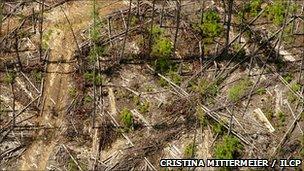Forest loss slows as Asian nations plant
- Published

The giant redwoods of California are among the iconic species protected, and yet at risk
Forest loss across the world has slowed, largely due to a switch from felling to planting in Asia.
China, Vietnam, the Philippines and India have all seen their forested areas increase in size.
There are also gains in Europe and North America, but forests are being lost in Africa and Latin America driven by rising demand for food and firewood.
The findings come in the UN Food and Agriculture Organization's (FAO) State of the World's Forests, external report.
Environmental groups are warning that priority needs to be given to old forests and the biodiversity they maintain in the face of climate change and growing demand for resources.
Rise of Asia
The FAO report's formal launch at UN headquarters in New York co-incides with the start of the UN's International Year of Forests, external.
The initiative aims to raise awareness of conservation among governments and other stakeholders.
The FAO is urging governments to explore ways of generating income from forests that do not depend on chopping trees down.
Forests now cover about 40 million sq km - just less than one-third of the Earth's land surface.
Although 52,000 sq km were lost per year between 2000 and 2010, that was a marked improvement on the 83,000 sq km annual figure seen during the previous decade.
Europe traditionally has been the region with the biggest increase; but now, Asia has overtaken it.
A net loss of forest in Asia during the period 1990-2000 has been transformed into a net gain in the decade since.
"China has increased its forest by three million hectares (30,000 sq km) per year - no country has ever done anything like this before, it's an enormous contribution," said Eduardo Rojas-Briales, assistant director-general of the FAO's forestry department.

Madagascar's forests have been hit hard by illegal logging following political unrest
"But we can also highlight the case of Vietnam, a small and densely populated country that's implemented very smart and comprehensive forest reform - or India, which has not controlled its population as China has and where standards of living are even lower.
"Nevertheless India has achieved a modest growth of its forest area, and the Philippines has turned things around as well - so we're seeing improvement across Asia except in the weakest states," he told BBC News.
Dr Rojas-Briales suggested Latin American countries where forest loss continues could learn from East Asian policies, in particular the adoption of land use planning.
The report cites agriculture as the leading cause of deforestation in South and Central America and the Caribbean.
In Africa, the need for firewood is the key factor.
Conservation call
In Asia, South America and Africa, the area covered by deliberately planted forests is increasing, which could mean that old-growth forests continue to disappear while plantations spread.
The report does not distinguish between the two kinds; but Dr Rojas-Briales said plantations overall were not expanding at the expense of old-growth forests, at least not in Asia.
This is supported by the report's conclusion that in the Asia-Pacific region, the area of forest designated for production has fallen since 2000, with an increase in lands set aside for conservation of biodiversity and ecosystem services.
However, as old-growth forest continues to disappear in some parts of the world, Conservation International is one of several environment groups pressing for increased attention on these areas and their special importance for nature.
"Forests must be seen as more than just a group of trees," said Olivier Langrand, the organisation's head of international policy.
"Forests already play an enormous economic role in the development of many countries as a source of timber, food, shelter and recreation, and have an even greater potential that needs to be realised in terms of water provision, erosion prevention and carbon sequestration."
Conservation International is highlighting 10 places in the world, external where forests of iconic importance are under threat, including the banks of the Mekong River and the wildlife it supports, the lemur-rich jungles of Madagascarm and the Californian Floristic Province, home of the giant sequoia.
All currently cover less than 10% of their original range.
There are concerns in some quarters that the UN scheme on Reducing Emissions from Deforestation and forest Degradation (Redd) may lead to forests being conserved simply because they store carbon, without taking account of their immediate benefits to wildlife and local people.